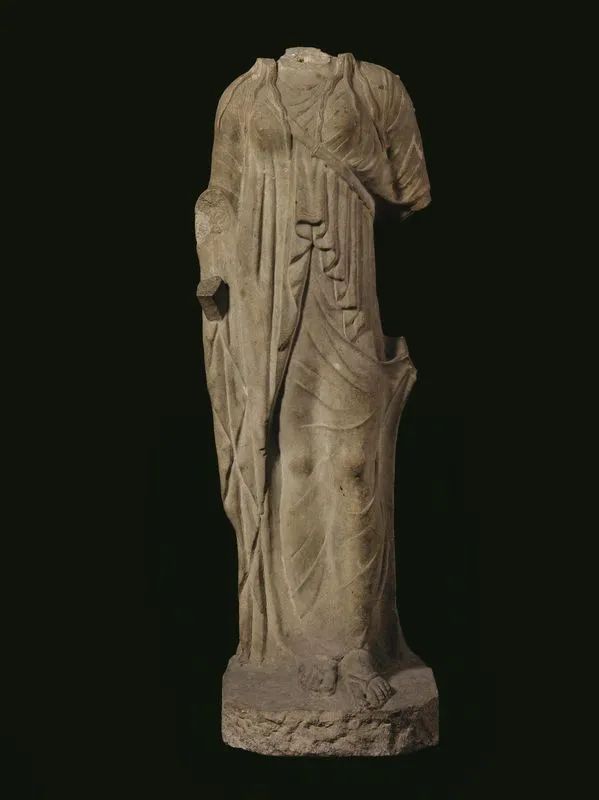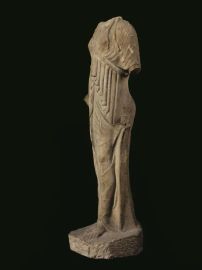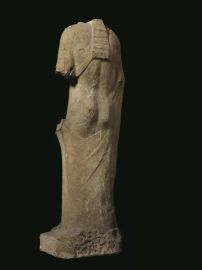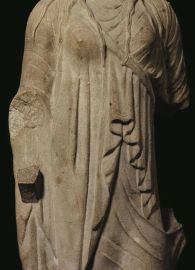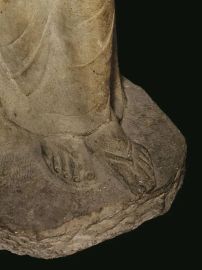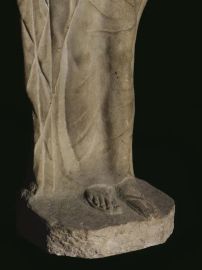STATUE OF ARTEMIS
NEO-ATTIC CRAFTSMANSHIP, END OF THE 1ST CENTURY B.C.
Medium grain white marble, sculpted and polished, height 130 cm
The goddess is depicted facing forward, her left foot slightly advanced, and the left one stepping back, and she stands on a quadrangular base. She is wearing a long chiton which reaches down to her feet with scalloped, almost metallic-looking folds, and clings to the body accentuating its curves. On top of the chiton we see the drapery of a mantle, which flows down partly covering the dress with rich zigzagging folds, and is held fast by small fibulae on the left shoulder. The hair flows down to the breast in long curly braids, but is gathered at the back of her head. Across her chest, the goddess is wearing the balteus which served to carry her quiver. The right arm featured a held out forearm, which is now lost, whilst the left arm ran down her side to hold up her dress. The goddess is wearing thin sandals on her accurately modelled feet, whilst the back of the statue was worked on rather summarily, as it was probably not visible in its original location, but the glutes are evidenced nonetheless.
The goddess is represented iconically and conceived to be seen mostly from the front, and the attention of the observer is immediately captured by the rich drapery of the mantle which takes on an importance nearly superior to that of the figure of the goddess.
Condition: the statue is missing the head, the right forearm, and left arm; there are traces of a bronze grip for the anchorage of the left arm.
This statue can be compared with two similar ones, also depicting the goddess Artemis, and held respectively at the National Archaeology Museum in Venice (inv. n. 59, fig. 1) which comes from a 1587 donation by the Grimani family, and at the National Museum in Naples (inv. n. 6008, fig. 2), which comes from the Domus Olconii in Pompeii, and was unearthed in 1760.
The venetian statue, which comes from the Collection of Giovanni Grimani, a venetian patrician and patriarch of Aquileia, was donated to Republic of Venice together with the rest of the collection, and was already known in antiquity. It is a smaller statue than the one we present in our catalogue, as it is 111 cm tall, whilst the Artemis from the Blanc Collection can be considered life-sized, as it reaches 130cm even without the head. The Pompeii sculpture is the same size as the Grimani one, and it still has its head, which was used to make the mould for that of the venetian one which was also missing its head. Both these sculptures represent the goddess in an inclined pose, unlike ours which is instead standing. However, the attire of the female figure is similar in all three statues; this fact, together with the rendering of the clothes through regular and schematic folds (which point to the artist’s interest for the detail, which thus takes on a decorative value in its own right) and the tendency to compress the volumes of the statue, all lead to the typical features of Neo-Attic sculptural workshops, in particular those of the artists closest to the circle headed by Pasiteles.
Neoatticism is a sculptural current which arose towards the end of the Roman republic. It was Heinrich Brunn who coined the term in his 1853 Geschichte der griechischen Künstler, in which he contrasted the masters of classical Athens with those Attic artists whose names appeared mostly in Italy on inscriptions where they were followed by the apposition ᾿Αϑηναῖος, thus qualifying them as “Neo-Attic” sculptors. These artists’ production, dated mostly from the 1st century BC, varied from fully-fledged three-dimensional pieces to marble vases and even other objects with high-relief decoration.
Already in the mid-2nd century BC Hellenistic courts such as those of the Attalids in Pergamum and the Ptolemies in Alexandria were looking to classical sculpture from the 5th and 4th centuries as paradigmatic. Consequently, ancient pieces were copied and partly re-elaborated according to a late Hellenistic taste, thus creating a peculiar series of sculptures in which different styles are accosted and melded together into a new kind of unity. A characteristic production for Neo-Attic sculpture is constituted by portrait statues: these are pieces in which, starting from a well-known sculptural type, a portrait-head of the acquirer is added to the body. Among the most famous examples of this we may count the statue of Emperor Hadrian at the Museo Capitolino, whose body reproduces the type of Alkamenes’s Ares Borghese, and the statue of Empress Sabina in Ostia, which uses the type of Kallimachos’s Venus Genetrix.
Since our statue lacks its head, it is impossible to know for certain whether it used to depict the goddess Artemis with her attributes, or a roman citizen who wished to be depicted in the guise of a goddess.
Comparative literature
G. Traversari, Sculture greche e romane del Palazzo Reale di Venezia, Venezia 1970;
Pompeii A.D. 79, catalogo della mostra, Boston 1978, p. 147, n. 82;
L. Sperti, Rilievi greci e romani del Museo Archeologico di Venezia, Roma 1988;
Le Collezioni del Museo Nazionale Archeologico di Napoli, Roma 1989, I, 2, p. 146 n. 257;
I. Favaretto, M. De Paoli, M.C. Dossi (a cura di), Museo Archeologico Nazionale di Venezia, Milano 2004

